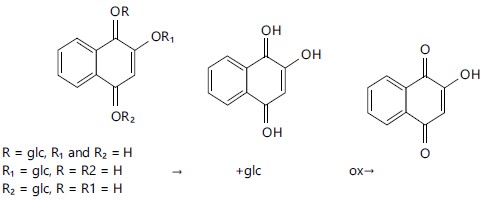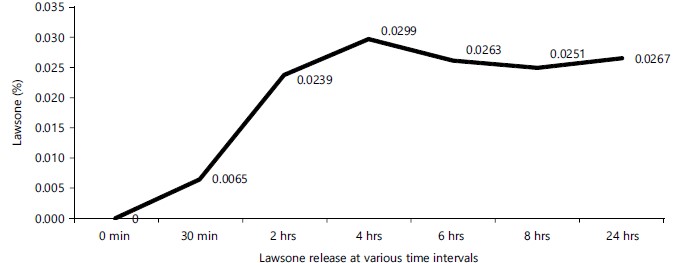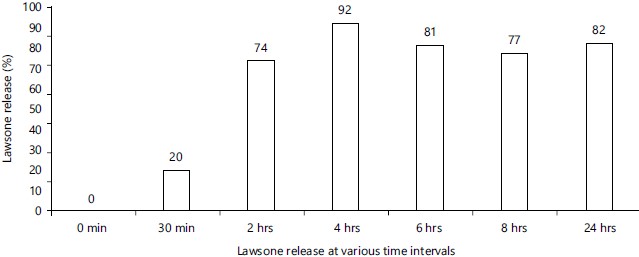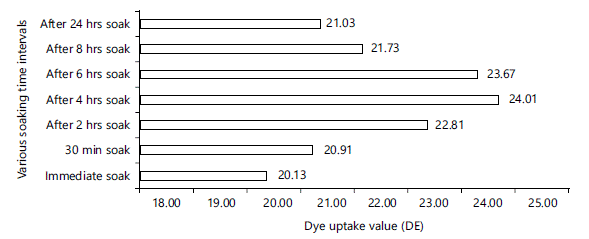Estimation of Lawsone Release from Lawsonia inermis Leaf Powder
| Received 15 Mar, 2022 |
Accepted 20 Jul, 2022 |
Published 18 Aug, 2022 |
Background and Objective: In ancient times people use various colouring materials for the hair to maintain the hair looking young and nourish look. Among the various herbal materials, the henna powder is very much pronounced with traditional users and it delivers an orange colour shade. The present attempt exclusively finds out the optimized time for the henna release through the quantification method and the results are correlated with dye out and dye uptake on the grey swatches. Materials and Methods: Pure henna powder was collected from high crop season in Rajasthan henna growing garden in India and tested the initial lawsone content through HPLC assay. At various time intervals, the lawsone release potential is estimated through the HPLC method, to estimate the lawsone kinetics. Results: The lowest lawsone release was recorded at 30 min and the value was 0.0657% the highest lawsone release was noticed in 4 hrs soaking samples and the lawsone value was 0.3014%. Around 4 hrs reach the maximum lawsone content i.e., 93% recovery noticed. Study results indicated that the maximum lawsone content was released at 4-6 hrs. The dye uptake value (DE) is higher in 4 hrs soaking time i.e., 24.01 unit, around DE value 4 unit lower in immediate and 30 min soaking time. Conclusion: Lawsone release value gradually increased with soaking time and reach the maximum at 4-6 hrs and then gradually decreased. Lawsone released a quantification study that was immensely useful to draw the usage pattern of henna powder for the consumer to follow the correct method to achieve the optimum active potential during the colouring practice and get the vibrant colour delivery.
| Copyright © 2022 Sankar et al. This is an open-access article distributed under the Creative Commons Attribution License, which permits unrestricted use, distribution, and reproduction in any medium, provided the original work is properly cited. |
INTRODUCTION
In recent days, hair dyeing is a regular practice to maintain their external beauty and maintain the social image of wellness. In ancient days various blends of herbal powders were used for the colouring purpose, among them, Henna and Indigo are very much pronounced in recent days also1,2. Natural hair colour technology is very much pronounced by the consumer due to the awareness of the carcinogenic problem of synthetic dyes. Natural hair colour or dyes are safe to use, it does not harm the hair and does not bleach. Many chemical dyes cause the scalp itching potential and some peoples are allergic to the chemical dyes, however, the plant dyes are safe to use and friendly to the scalp and even the environment also. Many herbals-based hair colour products are available in mass and premium range segments, which satisfies the consumer need for colouring and grey coverage, however, the application process and entire process are tedious. Lawsonia inermis is a natural material derived from powdered dried leaves of the Lawsonia inermis plant. An active potential colouring molecule named Lawsone chemically is 2-hydroxy 1,4 napthoquinone (CAS No. 83-72-7). In general, around 1-1.5% active component is present in the leaves3-5. In ancient times henna leaves and powder were used for the textile colouring the cloths and wool6,7. Many researchers exclusively work with lawsone on the hair coloring8-10. Among the various herbal materials, the henna powder is very much pronounced with traditional hair colour users and it delivers an orange colour shade to the hair. Usage of henna for dyeing the palms, fingernails and hair is an auspicious ritual during the festival seasons, an occasional function in most Asian countries. In addition to that many researchers investigated and reported the leaf contains quinones, phenylpropanoids, flavonoids, terpenoids, phenolics, fatty acids, carbohydrates, proteins, tannins, alkaloids, xanthan, coumarin, glucosides, saponins, triterpenoids, sterols and dioxin and its derivatives8,11. Many scientists proved that Mehndi leaf extract has many pharmacological properties like anti-fungal, anti-bacterial, anti-cancer activity property7. Overall many researchers proved that henna powder is safe to use on hair and skin and it does not cause any irritation to the skin or scalp like chemical-based hair colour4. In addition in that recent years, many people work towards a complete natural-based hair colour with a combination of henna, indigo, amla and other herbal materials. Henna leaf powder alone does not contribute to the colour, since the lawsone molecule does not present in the free state in the leaves, it is stored in the leaf in the precursor stage. The precursor is called a hennosides, during the consumer sample preparation time carried out the hydrolysis process it converts into the aglycone format and the aglycone is an unstable intermediate and it undergoes oxidation to convert the active molecule like lawsone8,12. For the hair colouring process, the consumer takes 1 part of henna powder mixed with 4 parts of water for colouring i.e., 20 g of henna powder mixed with 80 mL of water for colouring and kept overnight for the lawsone release. It is explained in the below pictorial representation13 (Fig. 1). Lawsone is present in glucoside format and mono glucoside unit attached with the phenolic group and named as 1,2,4-trihydroxynaphthalene-1-O-glucoside (Hennoside) and is also called as glycone unit. During the hydrolysis process, the glucose molecules are removed and formed the 1,2,4 trihydroxy naphthalene which is called an aglycone unit. In the final step, the aglycone unit undergoes oxidation and forms a colouring molecule namely 2-hydroxy1,4 naphthoquinones. The entire process is slow and takes time-consuming process. For this reason, the consumer kept the henna mixture overnight soaking in water before the application. The releasable lawsone readily reacts with skin/hair outer layers and binds with the protein molecules by Micheal addition and generates the colour8.
However, there is no authentic study report of the kinetics of lawsone release in plant leaf to the measurement of quantification study. Many researchers confirmed that soaking the henna leads to the maximum lawsone release and also many researchers indicate that the store was kept for longer times which leads to the degradation of lawsone content7,11,14. So, the present attempt exclusively finds out the optimised time for the henna release through the quantification method and the results were correlated with dye out and dye uptake on the grey swatches.
 Fig. 1: Pictorial representation of lawsone release from the henna leaves13 |
Complete releasing study and the study findings will be immensely useful to the end-user for the guidelines for the sample preparation, optimise sample preparation time and helps to achieve the maximum colour on the hairs.
MATERIALS AND METHODS
Study area: The entire study was carried out in MARICO Research and Development Centre, Mumbai, India between 2021 and 2022.
Sample collection: The pure henna powder was collected from high crop season from Rajasthan henna growing garden in India and tested the initial lawsone content through HPLC assay. Sigma Aldrich standard 2-hydroxy-1,4 naphthoquinones (Purity: Min 98%) acts as a reference standard. All the chemicals and reagents used for the studies were of analytical grade. All the estimations were carried out in triplicate and all the equipment was calibrated as per the good laboratory norms. Lawsone content in the leaves is exclusively measured by method IS-11142-20195.
Sample preparation: Accurately weigh 2000 mg of Henna powder into 100 mL containing volumetric flask, add sodium bicarbonate 5% (NaHCO3) solution till the mark and shake the contents every 1/2 hr or so till 8 hrs. Allow settling of the contents overnight. Filter through a filter paper, from the filtered solution, take 10 mL of the solution into a 25 mL volumetric flask and make it up with water. Filter the solution using a 0.45 μ regenerated cellulose filter and collect the clear sample for HPLC injection.
Standard preparation: Accurately weigh 20 mg of standard material i.e., 2-hydroxy-1,4 naphthoquinones into 100 mL containing volumetric flask and add the sodium bicarbonate 5% solution up to the mark. Take 1 mL of the stock solution into a 25 mL volumetric flask and make up a 5% sodium bicarbonate (NaHCO3) solution. Filter the solution using a 0.2 μ regenerated cellulose filter and collect the clear sample for HPLC injection.
Before injecting the samples column and chromatographic instrument were conditioned, each sample run time is around 20 min and measured the absorbance through a UV detector at 286 nm. Once the column gets saturated inject the blank solution i.e., diluent later on a standard solution and then sample and record the chromatograph and measure the response of the peak.
Henna paste or mixture for the kinetics study: Accurately weighed the 10 gm henna powder samples in a bowl and add the 40 mL water and make a uniform paste and kept aside for soaking. The following treatment samples were prepared for the kinetics study and the complete treatment was furnished in Table 1.
Colour uptake measurement: The single bundle swatches were used for the complete study to avoid inconsistent results. Prepared hair swatches washed with water and surfactant solution for complete removal of any oil dirt and foreign materials. The chroma meter reading was carried out for the freshly prepared hair swatches, an average of six readings was taken by the instrument and take the average for the calculation15.
| Table 1: | Henna soaking treatment for releasing kinetics study | |||
| Treatment details | Soaking time |
| 10 g henna powder mixed with 40 mL of water | Immediate |
| 10 g henna powder mixed with 40 mL of water | 30 min |
| 10 g henna powder mixed with 40 mL of water | 2 hrs |
| 10 g henna powder mixed with 40 mL of water | 4 hrs |
| 10 g henna powder mixed with 40 mL of water | 6 hrs |
| 10 g henna powder mixed with 40 mL of water | 8 hrs |
| 10 g henna powder mixed with 40 mL of water | 24 hrs |
Apply the treatment mixture to the hair swatch with help of a brush and kept aside for 60 min. After 60 min, wash the hair swatches with normal tap water until the water runs clear. Dry the washed swatches with a normal air dryer and kept the swatches aside for 2-3 hrs and take the colour uptake readings. Then colour reading (L*a*b* values) was taken for coloured swatches by chromameter as like as pre-reading. Dye uptake was calculated based on the below formula16:
| L scale | = |
Lightness to darkness, where a low number (0-50) indicates dark and a high number (51-100) indicates light for initial colour uptake |
| L1 | = |
Before colouring |
| L2 | = |
After colouring |
| a scale | = |
Red to green, where a positive number indicates red and a negative number indicates green for initial colour uptake |
| a1 | = |
Before colouring |
| a2 | = |
After colouring |
| b scale | = |
Yellow to blue, where a positive number indicates yellow and a negative number indicates blue for initial colour uptake |
| b1 | = |
Before colouring |
| b2 | = |
After colouring |
RESULTS AND DISCUSSION
Physicochemical parameters of henna leaf powder (IS 11142:2019) and the results were furnished in Table 2. Lawsone content was estimated through HPLC and quantified the available lawsone content, about 1.62% of lawsone was present in the leave powder and the results were identical to the previous study8,12. Many scientists and crop scientists estimated lawsone content varied between 1.0 and 2.0% in the leaf portion.
The henna powder was kept aside as per the consumer practices, periodical interval takes the small portion and tested the lawsone content through HPLC and releasable lawsone contents were summarised in Fig. 2. Test henna powder containing 1.62% of lawsone content at the initial level, as per the consumer practice of four-fold dilution and the available lawsone content in the bowl was calculated by using the below formula described in the method IS-11142-201955.
| Table 2: | Lawsonia inermis leaf analytical parameter estimation | |||
| Parameters | Specifications | Results |
| Appearance | Green colour free flow powder | Compiles |
| Odour | Green henna note | Compiles |
| Moisture and volatile matter | Max 10% w/w | 2.24% |
| Cold water extract | 25-32% w/w | 25.94% |
| Crude fiber | 10-15% w/w | 14.17% |
| Mineral matter | 8-12% w/w | 9.54% |
| Acid Insoluble ash | 3-6% w/w | 4.14% |
| Extraneous sand | Max 5.0% w/w | 3.01% |
| Presence of extraneous dye | Absent | Passes |
| Lawsone pigment | Min 1.0% | 1.62% |
| pH of 5% solution | 4.0-5.0 | 4.5 |
 Fig. 2: Lawsone release pattern from henna leaves through HPLC estimation |
 Fig. 3: Lawsone release (%) with various time intervals |
As per the theoretical calculation, the lawsone content is 0.324% in the bowl, the amount of lawsone release was estimated at various time intervals mentioned in Table 1. The lowest lawsone content was recorded at 30 min of soaking time and the value was 0.0657% the highest lawsone content release was noticed in 4 hrs soaking samples and the lawsone value was 0.3014%. Similar kind of observations was noticed in various research study11,15,17-19. Lawsone releases at various intervals are summarised in Fig. 3. In the current practice, the consumer soaked the henna for 2 hrs to overnight soaking, that was the reason that the consumer get the in-consistency colour delivery with different soaking times. Up to one hour of soaking time, only 50% of lawsone released from the leaf, the conversion from hennoside to lawsone was a slow process and takes around 4 hrs to reach the maximum lawsone content i.e., 93% recovery noticed. At 30 min soaking samples release only 20% of lawsone content from the leaves and 47% of lawsone released at 1 hr of soaking time. The value of ‘a’ indicated the red hue, if the ‘a’ value increase means the red hue increased. Study results indicated that the higher the lawsone content delivers the higher the red hue in hair swatches and the higher the ‘a’ value in the instrument also. Immediate soaking time delivers ‘a’ value around 10.0 unit and reaches the maximum after 4 hrs soaking 14.0 unit and then gradually decreased. Similar kinds of observations were reported by Maslovarić et al.13, their findings indicated that releasable lawsone readily reacts with nitrogenous compounds such as amino acids, proteins etc. Elimination of nitrogenous materials is a critical step towards the stabilization of the lawsone molecule in the extract. Many authors work towards the lawsone extraction with various organic solvents to remove the nitrogenous compounds11,13,15,17,20,21.
 Fig. 4: Dye uptake value (DE) releasable lawsone at various soaking time intervals |
| Table 3: | Choromometer dye uptake ‘a’ value with different soaking intervals | |||
| Treatment details | a value |
DE value |
| Immediate soak | 10 |
20.13 |
| 30 min soak | 11.66 |
20.91 |
| After 2 hrs soak | 12.69 |
22.81 |
| After 4 hrs soak | 14 |
24.01 |
| After 6 hrs of soak | 13.26 |
23.67 |
| After 8 hrs of soak | 11.75 |
21.73 |
| After 24 hrs soak | 12.46 |
21.03 |
Dye uptake value (DE) releasable lawsone at various soaking time intervals furnished in Fig. 4. Similarly, the dye uptake value (DE) is higher in 4 hrs soaking time i.e., 24.01 unit, around DE value 4 unit lower in immediate and 30 min soaking time. More than 4 hrs of soaking time also showed a slightly lower DE value. Overall DE values varied between 20.13 and 24.01 in various soaking time studies (Table 3). The entire lawsone release study is immensely useful to draw the plot of optimised time recommendation for the consumer practices. The current study confirms that the 4 hrs of soaking helps to release the maximum lawsone and delivers a better colour on grey swatches.
CONCLUSION
This study results indicated that the maximum lawsone content was released at 4-6 hrs and then gradually decreased the active potential around 5-8% level. It is further confirmed through the swatch assay. Lawsone quantification study was very useful to draw the usage pattern of henna powder for the consumer to follow the correct methods to achieve the optimum active potential during the colouring practice and get the vibrant colour delivery.
SIGNIFICANCE STATEMENT
Lawsone’s quantification study was very useful to draw the usage pattern of henna powder for the consumer to follow the correct methods to achieve the optimum active potential during the colouring practice and get the vibrant colour delivery. The entire study is immensely useful to recommend the appropriate consumer usage pattern to achieve the best colour delivery. Four hours socking release the maximum lawsone for the colour delivery.
REFERENCES
- Zaheer, Z., E.Y. Danish and S.A. Kosa, 2021. 2-Hydroxy-1, 4-napthoquinone solubilization, thermodynamics and adsorption kinetics with surfactant. Chin. J. Chem. Eng., 32: 212-223.
- Utkarsha, S. and K. Yash, 2020. Antimicrobial activity and isolation of lawsone from Lawsonia inermis using column chromatography. Res. J. Pharmacogn. Phytochem., 12: 219-223.
- Alam, M.M., M.L. Rahman and M.Z. Haque, 2007. Extraction of henna leaf dye and its dyeing effects on textile fibre. Bangladesh J. Scient. Ind. Res., 42: 217-222.
- El-Shaer, N.S., J.M. Badr, M.A. Aboul-Ela and Y.M. Gohar, 2007. Determination of lawsone in henna powders by high performance thin layer chromatography. J. Sep. Sci., 30: 3311-3315.
- Charoensup, R., T. Duangyod, C. Palanuvej and N. Ruangrungsi, 2017. Pharmacognostic specifications and lawsone content of Lawsonia inermis leaves. Pharmacogn. Res., 9: 60-64.
- Semwal, N., Y. Bijalwan, A. Rautela, D. Joshi and B. Singh, 2021. Usage of natural plants in herbal cosmetics. Juniper Online J. Dermatol. Cosmet.
- Singh, D.K. and S. Luqman, 2014. Lawsonia inermis (L.): A perspective on anticancer potential of mehndi/henna. Biomed. Res. Ther., 1: 112-120.
- Gallo, F.R., G. Multari, G. Palazzino, G. Pagliuca, S.M.M. Zadeh, P.C.N. Biapa and M. Nicoletti, 2014. Henna through the centuries: A quick HPTLC analysis proposal to check henna identity. Rev. Bras. Farmacogn., 24: 133-140.
- Almeida, P.J., L. Borrego, E. Pulido-Melián and O. González-Díaz, 2012. Quantification of p-phenylenediamine and 2-hydroxy-1,4-naphthoquinone in henna tattoos. Contact Dermatitis, 66: 33-37.
- Chukwu, O.O.C., C.E. Odu, D.I. Chukwu, N. Hafiz, V.N. Chidozie and I.A. Onyimba, 2011. Application of extracts of henna (Lawsonia inamis) leaves as a counter stain. Afr. J. Microbiol. Res., 5: 3351-3356.
- Hasan, M.M., K.A. Nayem, A.Y.M.A. Azim and N.C. Ghosh, 2015. Application of purified lawsone as natural dye on cotton and silk fabric. J. Text.
- Chaudhary, G., S. Goyal and P. Poonia, 2010. Lawsonia inermis Linnaeus: A phytopharmacological review. Int. J. Pharm. Sci. Drug Res., 211: 91-98.
- Maslovarić, I., V. Ilić, I. Drvenica, A. Stančić and S. Mojsilović et al., 2021. Insight into the biological activity of hennosides-glucosides isolated from Lawsonia inermis (henna): Could they be regarded as active constituents instead. Plants.
- Gallo, F.R., G. Multari, M. Giambenedetti and E. Federici, 2008. Chemical fingerprinting of Lawsonia inermis L. using HPLC, HPTLC and densitometry. Phytochem. Anal., 19: 550-559.
- Vaughn, M.R., R.A.H. van Oorschot and S. Baindur-Hudson, 2009. A comparison of hair colour measurement by digital image analysis with reflective spectrophotometry. Forensic Sci. Int., 183: 97-101.
- Popov-Raljic, J.V. and J.G. Lalicic-Petronijevic, 2009. Sensory properties and color measurements of dietary chocolates with different compositions during storage for up to 360 days. Sensors, 9: 1996-2016.
- Bennaceur, S., A. Berreghioua, L. Bennamoun, A. Mulet, B. Draoui, M. Abid and J.A. Carcel, 2021. Effect of ultrasound on henna leaves drying and extraction of lawsone: Experimental and modeling study. Energies.
- Patil, S. and D. Panchal, 2018. Lawsone: Natural colorant in fashion technology & textile engineering. Curr. Trends Fashion Technol. Text. Eng.
- Yang, L., T. Cai, D. Ding, T. Cai and C. Jiang et al., 2017. Biodegradation of 2-hydroxyl-1,4 naphthoquinone (lawsone) by Pseudomonas taiwanensis LH-3 isolated from activated sludge. Sci. Rep.
- Gonzalez-Lamothe, R., G. Mitchell, M. Gattuso, M. S. Diarra, F. Malouin and K. Bouarab, 2009. Plant antimicrobial agents and their effects on plant and human pathogens. Int. J. Mol. Sci., 10: 3400-3419.
- Daemi, A., M.R. Farahpour, A. Oryan, S. Karimzadeh and E. Tajer, 2019. Topical administration of hydroethanolic extract of Lawsonia inermis (henna) accelerates excisional wound healing process by reducing tissue inflammation and amplifying glucose uptake. Kaohsiung J. Med. Sci., 35: 24-32.
How to Cite this paper?
APA-7 Style
Sankar,
J., Kini,
M., Mhaskar,
S., Sangle,
P. (2022). Estimation of Lawsone Release from Lawsonia inermis Leaf Powder. Trends in Agricultural Sciences, 1(1), 28-34. https://doi.org/10.17311/tas.2022.28.34
ACS Style
Sankar,
J.; Kini,
M.; Mhaskar,
S.; Sangle,
P. Estimation of Lawsone Release from Lawsonia inermis Leaf Powder. Trends Agric. Sci 2022, 1, 28-34. https://doi.org/10.17311/tas.2022.28.34
AMA Style
Sankar
J, Kini
M, Mhaskar
S, Sangle
P. Estimation of Lawsone Release from Lawsonia inermis Leaf Powder. Trends in Agricultural Sciences. 2022; 1(1): 28-34. https://doi.org/10.17311/tas.2022.28.34
Chicago/Turabian Style
Sankar, Jayaganesh, Mridula Kini, Sudhakar Mhaskar, and Puja Sangle.
2022. "Estimation of Lawsone Release from Lawsonia inermis Leaf Powder" Trends in Agricultural Sciences 1, no. 1: 28-34. https://doi.org/10.17311/tas.2022.28.34

This work is licensed under a Creative Commons Attribution 4.0 International License.



